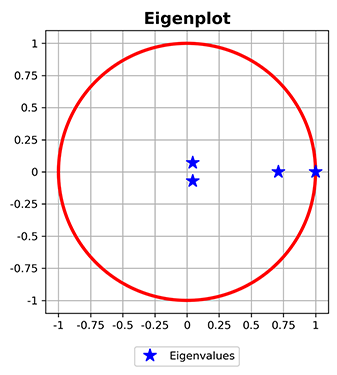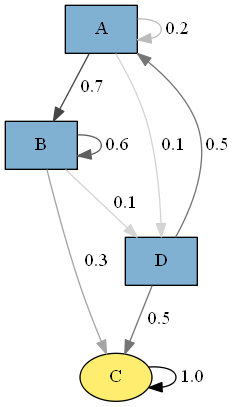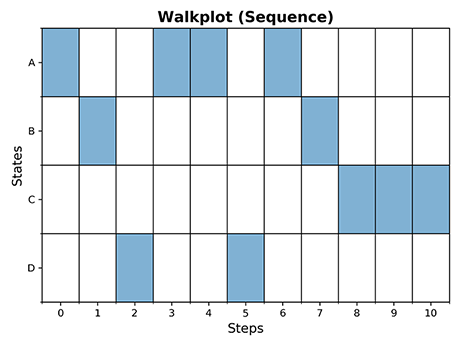A framework for discrete-time Markov chains analysis.
Project description
PyDTMC is a full-featured, lightweight library for discrete-time Markov chains analysis. It provides classes and functions for creating, manipulating and simulating markovian stochastic processes.
Requirements
PyDTMC supports only Python 3 and the minimum version required is 3.6. In addition, the environment must include the following libraries:
In order to use the plot_graph function, Graphviz and PyDot must be installed too.
Installation & Upgrade
Via PyPI:
$ pip install PyDTMC
$ pip install --upgrade PyDTMC
Via GitHub:
$ pip install git+https://github.com/TommasoBelluzzo/PyDTMC.git@master#egg=PyDTMC
$ pip install --upgrade git+https://github.com/TommasoBelluzzo/PyDTMC.git@master#egg=PyDTMC
Usage
The core element of the library is the MarkovChain class, which can be instantiated as follows:
>>> import numpy as np
>>> p = np.array([[0.2, 0.7, 0.0, 0.1], [0.0, 0.6, 0.3, 0.1], [0.0, 0.0, 1.0, 0.0], [0.5, 0.0, 0.5, 0.0]])
>>> mc = MarkovChain(p, ['A', 'B', 'C', 'D'])
>>> print(mc)
DISCRETE-TIME MARKOV CHAIN
- TRANSITION MATRIX:
A B C D
------- ------- ------- -------
A | 0.20000 0.70000 0.00000 0.10000
B | 0.00000 0.60000 0.30000 0.10000
C | 0.00000 0.00000 1.00000 0.00000
D | 0.50000 0.00000 0.50000 0.00000
- PROPERTIES:
ABSORBING: YES
APERIODIC: YES
IRREDUCIBLE: NO
ERGODIC: NO
- COMMUNICATING CLASSES:
[A,B,D] | [C]
TYPE: T | R
PERIOD: 1 | 1
Static values of a MarkovChain instance can be retrieved through its properties:
>>> print(mc.size)
4
>>> print(mc.recurrent_states)
['C']
>>> print(mc.transient_states)
['A', 'B', 'D']
>>> print(mc.steady_states)
[array([0., 0., 1., 0.])]
>>>print(mc.fundamental_matrix)
[[1.50943396 2.64150943 0.41509434]
[0.18867925 2.83018868 0.30188679]
[0.75471698 1.32075472 1.20754717]]
>>> print(mc.absorption_times)
[4.56603774 3.32075472 3.28301887]
>>> print(mc.topological_entropy)
0.6931471805599457
Dynamic computations on a MarkovChain instance can be performed through its methods:
>>> print(mc.expected_rewards(10, [2, -3, 8, -7]))
[-2.76071635 -12.01665113 23.23460025 -8.45723276]
>>> print(mc.expected_transitions(2))
[[0.085 0.2975 0. 0.0425]
[0. 0.345 0.1725 0.0575]
[0. 0. 0.7 0. ]
[0.15 0. 0.15 0. ]]
>>> print(mc.walk(10))
['D', 'A', 'B', 'C', 'C', 'C', 'C', 'C', 'C', 'C']
Plotting functions can provide a visual representation of a MarkovChain instance and its attributes. In order to immediately display function outputs, the interactive mode of Matplotlib must be turned on.
>>> plot_eigenvalues(mc)
>>> plot_graph(mc)
>>> plot_walk(mc, 10, 'sequence')
Project details
Release history Release notifications | RSS feed
Download files
Download the file for your platform. If you're not sure which to choose, learn more about installing packages.














